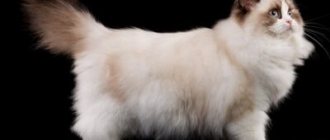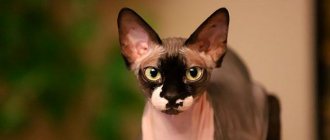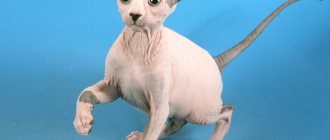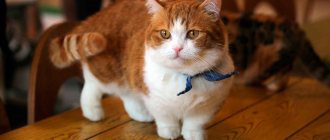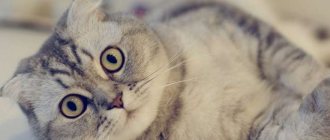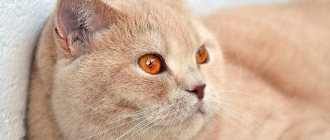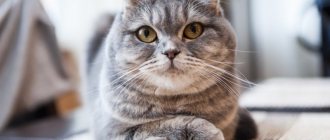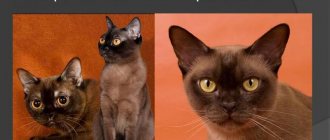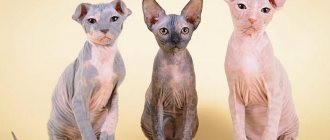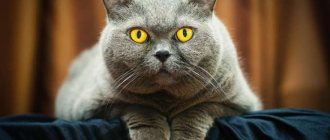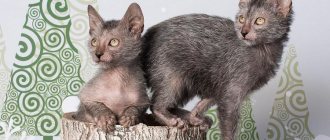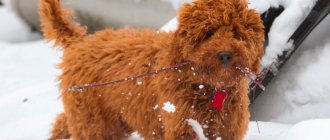Article navigation
Varieties of the Don breedVelor SphynxBrush SphynxFlock Sphynx Description of what it looks like and what colors there are Differences between the Canadian, Don and St. Petersburg SphynxesCharacter and special habits of the BrushSphynxHow to care for the Don SphynxCharacterHow to toilet train a SphynxRules for bathing a SphynxCharacter and behaviorPhoto gallery: Sphynxes live next to us - interesting factsWhy sphinxes have fur ?Sphinxbrush of the Don breedPetersburgbrush (Peterbald)Health How long do they live? Breeding the breedHow to choose a kittenTypes of coat of sphinxesFlockVelourBrushStraight-hairedHealth and susceptibility to diseases What to look for when choosing Prices for kittensPros and cons
Description of what it looks like and what colors there are
Any colors of the Don Sphynx are allowed, except lilac and chocolate. There are purebred Donchak dogs:
- white;
- black;
- gray;
- red;
- blue;
- red;
- pinkish.
Tabby-colored cats (patterned, striped) are also recognized by the felinological community, but they are classified into a separate subgroup, without division by pattern.
And here you will find the schedule of WCF cat shows for 2020.
Velours
Velor cats have longer and fuller coats than flocked cats. The Velor Sphynx is born with velvet hair that is clearly visible to the touch. The length of the villi can reach up to 3 mm. Velor Peterbalds have longer hair on their paws, face and tail than on other parts of the body.
With age, hair follicles die off. Velor Don Sphynxes completely lose their hair. In adulthood, these cats appear completely hairless. Adult Peterbalds may still have remnants of hair on their paws and head.
Character and special habits of brushes
These cats can be characterized as playful and inquisitive. Over time, they become full-fledged members of the family. They choose one master or favorite for themselves, they always obey him unquestioningly, carrying out all his commands. They treat other people with warmth and good nature. Also, the Sphynx Brush is intelligent, but tends to be touchy. However, he is not vindictive. You should not punish this animal physically and psychologically.
Brushes can be called empaths, capable of sensing changes in a person’s mood. They react to this, trying to pity and cheer up the person. Cats love affection, all kinds of manifestations of tenderness, care, and attention to themselves. This breed is characterized by quickly getting used to a new place, observing all the requirements that the owners place on them. If the animal refuses to visit the tray assigned to it, you just need to move it to another place.
Sphynx kittens.
Hairless Sphynx cat: character
The unique character of the Sphynx, as well as their appearance, is the result of careful selection. These animals are not prone to displaying aggression or discontent. Kind, soft, sensitive, gentle, devoted Sphynxes are ideal pets.
They get along well with both older people and families with small children. A balanced character combined with a playful disposition helps these animals share the interests of each family member.
Sphynx cats get along well in families with small children.
IMPORTANT: Sphinxes are not vindictive, they quickly forget random insults, but they have a hard time experiencing loneliness.
Sphynxes love to interact with people and pets. They are not afraid of large dogs and lack the hunter's instinct, so a hairless cat's best friend can be a huge bulldog, a hamster or a parrot.
Sphynxes are playful and curious animals
Character
Velor beauties are very affectionate
Don Sphynxes are friendly cats. These are companions who are happy to spend time next to people: they love to lie on the couch with their owner, and run after a person around the apartment. Purrs, as sociable animals, find it sad to be alone for a long time. They are loyal, non-aggressive, but can be offended if the owner swears loudly.
The tailed cats of this breed are comfortable with living with dogs and other medium-sized pets. In addition, they get along with children: they are ready to play with kids and do not scratch. Animals are especially active when they are young. Adult cats prefer a quiet rest, but sometimes they are not averse to frolic.
Don Sphynxes are distinguished by their intelligence. They can be trained. But at the same time, you cannot roughly force the animal to obey, otherwise the pet will become stubborn. It is better to use the reward method - for each execution of a command you need to treat the cat with a treat. Hairless purrs can learn different tricks. Tailed animals are able to understand the requirements to “sit” and “lie down”. They love to fetch the ball.
Advantages and disadvantages of the breed
Sphinxes freeze quickly. To keep the tailed one from being cold, you can put clothes on it.
Velor sphinxes have many advantages:
- Devotion. The pet becomes very attached to its owner. He is ready to meet and escort a person from and to work at the door. Some owners believe that the habits of such a cat are similar to the behavior of dogs.
- Lack of aggression. Tailed animals are friendly towards family members and their guests. They often behave affectionately. These animals do not take revenge, are not jealous, and do not show malice. Although sometimes sphinxes can get offended.
- Sociable. They are the first to make contact, they love to jump on your lap, purr and meow.
- Fast adaptation. They are easy about changes and do not experience much stress when moving to a new home.
- Trainable. Animals are obedient and can learn to follow different commands.
- Less demanding in care when compared with hairless cats and fluffy tailed cats. Compared to velor purrs, “naked” sphinxes get dirty faster. And due to the fact that cats have very little fur, they do not need to be combed. In addition, no hair remains on the furniture.
The disadvantages include:
- Obsessiveness. A cat can walk next to its owner all day and demand attention.
- Frequent feeling of hunger. This is due to the characteristics of the animal’s metabolism and heat exchange. Sometimes your pet will beg for food or even steal.
- Disgust towards dirty cups and tray. The owner will have to frequently wash the cat's accessories and change the litter in the toilet.
- Sphinxes cannot stand being alone for long periods of time. They may feel sad and stressed.
- They freeze quickly. You need to monitor the temperature in the room.
How to toilet train a Sphynx
Sphynxes are clean animals and are easily litter trained. If your pet ignores the toilet, it means he doesn’t like something. Try choosing a different tray or experiment with fillers. Do not use physical force or scold your pet during training.
Do not miss
- Do not miss
How to train a kitten to use a litter box in an apartment: step-by-step instructions
It is not recommended to use silica gel filler: the baby may accidentally swallow the “balls” and get poisoned. Life hack: before pouring the filler, place the bag on the tray - this way the plastic will not absorb the smell. During cleaning, collect the film and throw the granules into the trash.
Price
You should only buy a kitten from trusted breeders or nurseries; a sick or outbred animal may be slipped into the market.
It is necessary that the parents and the baby have documents; it is better to conclude an agreement with the seller. Pay attention to whether vaccinations have been completed and whether worm prevention has been carried out; do not take a four-legged animal under two months old.
He must be active, without external defects, and cheerful. The average price of such a kitten is ten to fifteen thousand rubles, but can reach up to twenty-five thousand. Always pay attention to the conditions in which the hairworm is kept. If the apartment is clean and tidy, and the baby’s parents look healthy and well-groomed, then most likely this is a bona fide breeder.
Rules for bathing a sphinx
Hairless cats love bath treatments. The optimal water temperature is 36-38 degrees.
How to bathe a Sphynx:
- There is a rubberized mat at the bottom of the bed bath to prevent your pet's paws from slipping.
- Use special products for washing hairless cats, and make sure that the liquid does not get into the eyes and ears.
- After the bath, dry the kitten with a soft towel, take it to a warm place or cover it with a blanket.
- Do not dry your pet with a hairdryer - dry and hot air can burn the delicate skin.
Character and behavior
Owners of “bald cats” are convinced that their pets have the highest level of intelligence among domestic cat breeds - it is quite possible that this is so. All Sphynx cats are very affectionate and affectionate cats. They are dog-oriented and interested in their owner, they train well and explore the world around them with great curiosity.
The Sphinx cannot imagine her life without her beloved owner
Loneliness is not for them, keep this in mind if you are planning to get a Sphynx. Donchak dogs are more self-confident and, at least for a short time, will be able to find something to do to pass the time while waiting for the owner. Canadians are very sensitive, withdrawn and fixated on their rich inner world - being left without an owner, they suffer greatly. Peterbalds are emotional, active and will constantly “tell” you about all their activities and fun.
These cats are bright, unique personalities, and this certainly has nothing to do with the type of coat they have. Much more important is whether you can find mutual understanding with them - then your life will become more interesting and sparkle with new colors.
Photo gallery: sphinxes live next to us - interesting facts
They are friends with pets and seem to consider themselves a little like dogs. Sphinxes hardly feel pain and often get burned while warming themselves on a stove or radiator. They love to dress up and be photographed. The Sphinx is ready to follow its owner everywhere. The hunting instinct of sphinxes is highly developed. They are cunning and gluttons for food. It’s better to hide it from them They know how to not only warm the owner, but also treat him Sphinxes like shiny toys, why is unknown An uncomfortable or ugly outfit can greatly spoil the Sphinx’s mood The Sphinx should be dressed for a walk so that the grass does not cut the delicate skin Sphinxes love to sleep in the embryonic position - it’s warmer this way Sphynxes recognize themselves in the mirror, other cats rarely know how to do this They say that they understand humor - but they definitely know how to smile!
Reviews
Almost all owners of velor cuties speak positively about them; they claim that their life has become much more interesting and enjoyable after the appearance of such a pet in the house. He is incredibly affectionate and can make anyone laugh, lifts the mood and helps relieve stress. Cats purr and meow constantly, but they do it unobtrusively and almost musically.
Many people note that such cats eat funny - they open their mouths as wide as they can, grabbing food. If you give them a tasty treat, they will take it with their paw, bring it to their nose with interest, examine and sniff it, and then intelligently eat it. They are extremely photogenic and love to pose. Those owners who have children note that such an animal becomes a source of pride for the child; he boasts about it to friends and often plays with it.
Why do sphinxes have fur?
The appearance of new hair on an animal of this breed, or, conversely, its disappearance after the woolly kittens grow up, is associated with many factors. There will be no clear answer. The reasons may be the following:
- The appearance of hairiness is sometimes influenced by vaccinations;
- hormonal manifestations of the individual associated with bearing kittens;
- unsuccessful selection of feed;
- weather;
- castration.
If a litter has ideal parents, but one of the kittens was still born with hair, do not forget that he had great-grandparents who gave the baby hair.
In the end, the lack of fur only reduces the price of a kitten, but does not in any way affect its character, which is sweet and good-natured, like all sphinxes.
Health and disease of the Brush Sphynx
Once every three months, the cat needs to be prevented from worms, and revaccinated once a year, according to the recommendations of veterinarians. One of the most common problems these animals face is diseases associated with the skin - dermatitis, irritation, rashes, etc. Congenital pathologies are rare in this breed, but they can acquire diseases that are more characteristic of them.
- Microphthalmos. A congenital pathology of the eyelids, in which the eyeball is smaller or underdeveloped, which can cause poor vision or complete blindness. The reasons for this have not been fully identified and are only being studied. With this pathology, veterinarians simply remove the damaged eye and, if possible, perform plastic surgery.
- Short lower jaw. Most often, this pathology occurs among Donetsk residents. In this case, an incorrect bite occurs, the jaws come into contact with each other and do not completely align.
- Turning of the eyelids. Characterized by weakening of the muscles of the eyelid ligaments. Solved surgically.
- Dermatitis. Type of skin disease.
- Nipple hyperplasia. It is often transmitted genetically through the female line. The risk group includes females with light blue tones.
- Trichophytosis. The type of fungal disease is similar to lichen.
The breed is distinguished by its strong health. If you follow proper care, a balanced diet, contact veterinarians on time and get all the necessary vaccinations, your pet will be a joy for a long time. They rarely get sick, thereby causing their owners trouble and expense.
Petersburg brush (Peterbald)
Russian breed, in the selection of which Don cats took part. Just like their predecessors, these sphinxes are covered with curly hair and some of them remain in this form for the rest of their lives. The second half “undresses” not completely. In adult cats, dense growth is observed on the face, tail and may be on the paws. This option is called brush point due to the characteristic location of the hair at the ends of the body.
Interesting facts about the Don Sphynxes
- Naked cats sweat.
- The bodies of completely naked, “rubber” Don cats are covered with a sticky film.
- Sphynx cats have a fast metabolism, so they should be fed more often than regular “furry” purrs.
- The Don cat is a super healer! Cats have long been considered healers for their ability to find a diseased organ in a person, then lie on it, and warm the sore spot with the warmth of their body. Due to their elevated body temperature, sphinxes can rightfully be considered super-healers, since the healing effect of contact of human skin with the naked skin of a cat is much higher.
- Injecting a sphinx is very problematic due to the thickness of the skin and the abundance of folds.
Health
The grass is good for the health of cats
Due to the fact that the skin of some velor Sphynx cats is not completely covered with dense hair, they are susceptible to skin diseases:
- dermatitis (purulent ulcers and rashes appear);
- acne (accompanied by the appearance of comedones, blackheads);
- fungal infection.
In addition, representatives of this breed are genetically predisposed to diseases:
- entropion (the edges of the eyelid turn inward);
- carp bite (a pathology in which the animal’s lower jaw is shortened: it is difficult for the cat to eat, the fangs injure the upper palate);
- microphthalmos (one or both apples are reduced in size);
- conjunctivitis;
- nipple hyperplasia;
- curvature of the caudal spine;
- breast cyst.
In order for a purr to be healthy, it must eat properly and receive all the substances necessary for the body. The Sphynx's ears should be cleaned regularly to prevent ticks from infesting them. In addition, it is important not to forget to vaccinate your cat. The first vaccination is given to a two-month-old kitten; after 4 weeks, revaccination is carried out. At 6 and 12 months, a second vaccination with a complex drug is given. After this, the tailed animal is vaccinated every year. And for preventive purposes, it is necessary to carry out deworming.
If you notice that your four-legged friend has become lethargic, and redness and irritation have appeared on the body, do not try to figure out the disease on your own. Take the animal to the clinic.
Feeding
A velor kitten up to 3 months old should eat 5 times a day
Velor Sphynxes have an accelerated metabolism. To maintain the required body temperature, they consume more food than purrs of other breeds. Premium or holistic food is suitable for them. They contain quality ingredients and healthy vitamins. Such products include:
- Orijen Cat & Kitten;
- Purina Pro Plan;
- Royal Canin Sphynx Adult.
If you decide that your pet will eat natural food, try to maintain a balance between serving size and quality. Sphynxes can be given: lean fresh meat, boiled vegetables, cereals, eggs and sea fish. Do not feed cats: river fish, pork, bones, sweets. Representatives of this breed do not chew food well, so there should not be large pieces in his bowl.
Animals that eat natural foods need mineral supplements and vitamins. Find out at your veterinary clinic which medications are suitable for your pet.
Tailed animals up to 3 months should eat 5 times a day, kittens up to 6 months - 4 times. After 6 months they can eat 3 times a day. When changing your cat's diet, you need to follow your veterinarian's recommendations.
How long do they live?
On average, Don Sphynxes live 14-15 years. Castration (sterilization) increases the life expectancy of individuals of both sexes. If the owner does not plan to engage in breeding, veterinarians recommend this operation. However, keep in mind that you will have to change your diet in many ways after sterilization.
Thanks to it, the pet’s hormonal levels stabilize. In cats, the risk of developing prostatitis and testicular cancer disappears; in cats, diseases of the mammary glands and reproductive system disappear. Donchak people become friendlier and lose interest in running away from home. This is especially important for sphinxes. On the street, without human care, they can die in a few hours, since they are absolutely not adapted to a “free” life.
It is recommended to castrate cats at 7–8 months, after the testicles have completely descended into the scrotum. Cats are spayed at 4-5 months (before their first heat). This increases the lifespan.
Breeding
Now the Don Sphynxes are popular. Therefore, there should be no problems with their breeding. Puberty in cats occurs six months after birth. But females are bred only after the third heat. Optimal age: 1-1.5 years.
Pet class cats are not allowed for breeding and exhibitions. Animals in this category are pets and do not participate in the development of the breed's gene pool. Therefore, carefully study the pedigree of your cat, as well as all the papers that the breeder gave you.
Before breeding, the animal must be healthy and vaccinated. The first signs of pregnancy in a cat appear after 3 weeks; on average, pregnancy lasts 64 days. Typically cats give birth to 4-6 kittens.
Flock
Newborn kittens may appear hairless. But upon closer examination, you can notice sparse hairs no more than 2 mm long on the skin. The Sphynx flock has wool that resembles velvet in its structure. It covers the entire body of the animal.
The short coat persists only in childhood and young adulthood. As the animal grows, the hairs gradually become thinner and then disappear altogether. By about 2 years of age, cats become completely hairless.
How to choose a kitten
It is recommended to purchase a kitten only from trusted nurseries, since they may offer you not an exotic baby, but a sick animal. This is due to the difficulties of breeding the breed and the dishonesty of sellers.
You should not buy a kitten that is too young, as its body is still weak and can get an infection when moving, even under stress.
Reference! The optimal age for a baby to buy starts from 3 months. By this time, the baby is already strong and has the necessary vaccinations.
If your future pet is a personal companion and not a show winner, then it is enough to make sure that he is healthy. The kitten should be active, cheerful, and not show aggression or fear at the sight of a person. Sometimes kittens have a small rash on their tail - there is nothing wrong with that, it will go away on its own over time.
The final color of the kitten, as well as the color of the eyes, become clear to an experienced breeder already in the first weeks of the baby’s life.
It’s worth noting right away that sphinxes are not a cheap pleasure. If you are offered to buy a kitten for 3-4 thousand rubles, in this case there can be no talk of any pedigree.
The price of kittens in trusted nurseries starts from 10 thousand rubles.
Kittens that have deviations from breed standards are a little cheaper. They are not critical if you take a handsome bald man for your soul.
But promising kids - potential exhibitors and future producers, whose parents have championship titles, will cost at least 15 thousand rubles .
Colors
The colors of hairless cats are varied. But due to the lack of wool, they do not look very bright. The colors themselves can be divided into several groups - solid, points, and patikolours. Solid or solid colors include:
- White. This color is found in all breeds. Don Sphynxes with this coloring may have cream shades than pure white.
- Black. In color painting it is called seal point. Black individuals have varying degrees of skin pigmentation. It can be from dark black to gray. When determining color, you need to examine the paw pads, nose and ear rims. Eyes can be any color.
- Blue. This color is a lightened version of black. May appear as baby blue or light grey.
- Red. This color cannot exist without tabby coloring. Newborn red kittens are often confused with cream kittens.
- Cream. Lightened version of red.
Tortoiseshell colors are unique to cats and there are several types of tortoiseshells:
- black tortoise is a combination of black and red colors;
- The blue turtle is a combination of cream and blue.
White sphinx.
Black Sphinx.
Blue Don Sphynx.
Red Sphinx.
Cream Sphynx.
Tortoiseshell color.
An important condition for determining the color of a turtle is the ability to distinguish it from a tabby-torby. The tortoiseshell color is a combination of black, red or cream. There are also other types of colors of Don Sphynxes:
- Chocolate. This variant is black in color, in the eastern group it is called “Havana”. This type of color is rare and atypical for Donetsk residents.
- Particolors. There are some variations of this color, calico and bicolor. This type is a tortoiseshell color with a combination of white. More than half should be white. Bicolors are a mixture of the main coat color and white. The proportion can be 9 to 1.
- Color points. These colors are found in all cat breeds and the Don Sphynx is no exception. It is a mixture of three or more colors in varying proportions.
- Tabby. Can be classic, spotted black, brindle.
The Don breed does not have different patterns on its body. It is extremely difficult to see them on naked animals.
Material on the topic: popular colors of the Scottish cat breed.
Types of Sphynx coats
Brush animals were not bred on purpose - they appeared as a result of a gene mutation after crossing different types of cats. There are several types of Sphynx with fur, differing in the length and type of hair.
Flock
The body of pets is covered with a thin velvet pile, similar to the fluff on the surface of a peach. The fluff is very soft to the touch and almost invisible. The densest coat is found on the paws and tail. In the absence of developmental anomalies, by the age of 2 years all the hairs fall out on their own, and the animal’s skin is completely exposed.
Velours
The velor pet of the Sphynx breed has a bald head, and the hair length on the body reaches 2–5 mm - in appearance they resemble partially bald street cats. Most often, by adulthood, these animals also become bald, but sometimes the fur remains throughout their lives. Often the lint remains only on the paws and tail.
Brush
Pets of this breed differ in the density of their coat:
- Brush velor Sphynx kittens have hard hair that resembles stubble. On the sides and neck the fur is thinner, the skin is visible through it. With age, the fur can soften, and then the velor brushed Sphynx becomes more similar to representatives of the flock breed.
- After birth, the body of the Pointed Brush is covered with long and thick hair, and a barely visible bald patch stands out on the head. By 18–24 months, the length of the hair on the body remains about 1–2 mm, and on the tail, muzzle and paws the hair reaches 10 mm, becoming curly in some places.
- A kitten of the dense brush breed looks like an animal with straight fur - it does not have a bald spot on its head. Over time, the structure of the hairline changes - it becomes thick, and the skin is practically not visible through it. On the paws, chest and tail, the hair is longer and stiffer, and can be either straight or curly.
Note! Pets of this breed do not take part in exhibitions, but they are crossed with other types of sphinxes - this allows them to get strong offspring. This selection is due to the fact that when two representatives of hairless sphinxes are brought together, very weak or dead kittens are born.
Straight-haired
Straight-haired Sphynxes do not go bald over the years - they still have short hair that fits tightly to the skin, and pronounced, long whiskers. The breed appeared as a result of the mixing of Siamese or Oriental cats with Sphynx cats.
Origin story
In 1996, the World Cat Federation recognized the Don Sphynx, including velor
The history of the formation of the Don Sphynx breed began in 1986 in Rostov-on-Don. City resident Elena Kovaleva noticed on the street how hooligans were mocking a kitten. The woman scared the boys away and took the little purr to her home. She named her new pet Varvara. Later, the owner noticed how the animal began to go bald. Veterinarians found no disease in the cat, and no treatment stopped the hair loss. Varvara became completely “naked”, but at the same time remained healthy.
Four years later, the cat gave birth to kittens from a shorthair cat. The babies, like their mother, turned out to be bald. Of all the newborns, the cat named Chita, who had velor fur, survived. Soon Irina Nemykina took her. She bred kittens and secured the genetic qualities of the animal. Thus, Chita became the ancestor of a new breed. During the breeding process, 4 types of Don Sphynx were bred: bald, brush Sphynx, velor and Don flock Sphynx. Hairless cats have no fur at all. The flock representative of the breed has short hairs on the body (they fall out by the age of two). Velor purrs have fur that grows up to 3 millimeters (may fall out with age). Brush hair is hard and sparse.
Gradually, bald tailed animals became popular. In 1992, the standard of the Don Sphynxes was determined. Then in 1996, the World Cat Federation and felinological organizations recognized cats.
What to look for when choosing
Don Sphynxes are extremely demanding pets to care for. Deprived of a natural protective coat, they must have strong immunity, resistant to external threats. Breeders advise buying kittens of this breed only in specialized nurseries. This makes it much more likely to get a healthy, mentally stable pet.
Advice! You need to take the little Donchak to a new home no earlier than 12 weeks. Babies are very fragile and often die at an early age, so they cannot be separated from their mother early.
In addition to good health, three-month-old kittens have a number of other advantages: they are litter box trained, socialized, and have received the necessary first vaccinations. The breeder must give the baby's veterinary passport with vaccination records to the new owner.
Don Sphynx kitten
It is advisable to buy a Donchak in the place where he was born and grows. This will provide an opportunity to observe the behavior of the kitten’s parents, brothers and sisters. Adult animals should behave calmly.
Unreasonable aggression may indicate shortcomings in the upbringing or health problems of the pets. Such individuals are disqualified and are not allowed for breeding. Little cats are always very curious, playful, and enjoy meeting new people.
The appearance of kittens may vary depending on the type of cat. Hairless Donchas are born bald, velor or flock are covered with sparse hairs, which are “shed” as the cat grows up. Brushes are born with fairly thick fur and acquire a characteristic appearance only in adulthood. Up to two years, the covers of the Don sphinxes are unstable. Naked individuals can be covered with fluff in winter; brushes sometimes go into the category of folk or velor.
The kitten needs to be examined carefully. A healthy purebred Sphynx has the following characteristics:
- almond-shaped eyes without signs of suppuration;
- the tummy is round, but not bloated;
- teeth white, straight;
- pear-shaped body;
- The ears are clean, wide at the base, rounded at the tips.
The skin of little Donchak needs to be examined especially carefully. You should refuse to purchase if you notice the slightest signs of peeling, rashes, or eczema.
Prices for kittens
You should not respond to advertisements on the Internet in which owners offer to buy a Don Sphynx kitten for an amount from 3 to 5 thousand rubles. At this price they sell defective individuals from unplanned (or frequent) matings. There is a huge risk of buying a sick, non-viable baby. So how much does a purebred kitten cost?
Cat breed British Chinchilla, a long-haired miracle with green eyes and a calm character
The cost of a kitten in a nursery depends on the cat’s exhibition data and the “merits” of its parents. A purebred pet-class Donchak (with deviations from breed standards) costs 7–8 thousand rubles. This pet is suitable for those who want to buy just a pet. He has all the necessary documents, has characteristics characteristic of the breed, but does not participate in exhibitions and matings.
Breed-class cats can be bought for 15,000 rubles. They do not receive first places at exhibition events, but are allowed for breeding. Representatives of the show class, born from champions, with excellent prospects, cannot cost less than 30,000-35,000 rubles.
Care and maintenance
Hairless cats are not adapted to outdoor conditions. Due to the lack of fur, the Don cat cannot be allowed outside in cold weather. Staying in the cold can cost a Donchak his life.
If, in addition to a naked cat, there are also pets in the house that take street walks, the Rostov Sphynx should be vaccinated without fail - walking brothers can bring infection to their paws and fur.
The Don Sphynx should have his own wardrobe - warm suits and blankets for the bald little frog are unlikely to be superfluous. If the house is cold, so that the heat-loving pet does not freeze, you should warm up the room, and dress the frozen Sphynx in warm clothes.
Mandatory hygiene procedures for a hairless cat are: brushing teeth, caring for the ear, daily eye washing, trimming claws. There are no eyelashes on the eyelids of Don cats, so caring for the eyes of a Don cat should be more thorough than for the eyes of an ordinary purr. Care is simple, but eye hygiene should be carried out regularly - every day you need to wipe the eyes of a Donetsk resident with a cotton pad soaked in either boiled water or a weak chamomile decoction. If the owner notices redness in the pet's eyes, or finds purulent discharge there, the animal should be immediately taken to the veterinarian.
The ears are treated with a cotton pad or swab moistened with a special lotion. Hygienic procedures for the auricle should be carried out carefully so as not to damage the pet’s delicate ear.
What to feed
A naked kitten cannot be suddenly switched to other foods - at first, the little donkey should be fed only with the food that he is used to eating while living with the breeder. New foods should be introduced into the baby’s diet in small quantities, gradually.
If it is enough to feed an ordinary cat 2 times a day, then this is not enough for a Don cat. Hairless cats spend too many calories generating heat to warm themselves, so they are fed more often than their woolly relatives - the Rostov Sphynx should be fed 3-4 times a day. Don Chaks have a high metabolism and require more food than other cats.
You can feed Don breed cats both dry food and natural food. If the owner’s choice fell on “drying”, then super-premium or holistic is best for a hairless pet.
Lean meat should predominate in the Donchak's natural diet. Lean beef, chicken or rabbit meat is cut into small pieces to make it easier for your pet to chew food. Meat can be given both raw and boiled.
In addition to meat, you can offer a naked cat deboned sea fish, water porridge (rice, buckwheat), low-fat fermented milk products (cottage cheese, kefir, fermented baked milk, yogurt), and vegetables.
If your pet is on a natural diet, then be sure to give vitamin complexes designed specifically for cats. If the cat eats dry food, then there is no need to give additional vitamins and minerals - they are present in ready-made food.
Some breeders prefer to keep their pets on a mixed diet, giving the animals both dry food and natural food. This decision depends on the preferences of the pet and the thickness of its owner’s wallet.
Skin and coat care
A hairless folded cat needs to be bathed more often than its furry relatives - 1-3 times a month. Bathing water should be heated to 38 degrees. The room where you plan to bathe the hairless cat should also be thoroughly warmed up. After bathing, you should not allow your pet to be exposed to a draft. Heat-loving Don cats are afraid of drafts.
In addition to routine bathing, attention should be paid to caring for the Sphynx's numerous folds. To prevent diaper rash in the folds, you should wipe each fold with a damp cloth every week. For this procedure, you should choose alcohol-free wipes.
Potential Health Problems
Donetsk residents have good immunity, so they are little susceptible to infectious diseases. However, Don Sphynxes have plenty of problems associated with the characteristics of the breed.
For example: Don cats are born sighted, but they do not have eyelashes. Newborn kittens have poor coordination - babies constantly bump into objects and obstacles, and their eyes are not protected by cilia. This may cause injury.
In addition to injuries, the eyes of the Don cat are susceptible to diseases such as conjunctivitis, corneal ulcers, and scleritis. Microphthalmos is a disease that leads to decreased vision and blindness. Don breed kittens are often born with tumors on the eyes or with a cyst. Such ailments can be eliminated surgically.
Don cats often give birth to kittens with an underbite (carp bite), which over time can provoke an unpleasant oral disease - gingivitis.
It would seem like a small thing - the birth of a kitten with a crooked tail. Among Don Chaks, kittens with crooked tails are born in every second litter. Just think, it’s just a cat’s tail, a common defect, what health problems could there be? It turns out that there can be problems caused by a crooked tail - firstly, animals with crooked tails are not allowed for breeding. Secondly, this disease is often accompanied by additional troubles - an animal with a tail fracture may have underdeveloped intestines, shortened thoracic and cervical vertebrae, or the kitten will suffer from weakness of the anus.
Advantages and disadvantages
Don Sphynxes have many advantages:
- Cats get along well with children and other animals.
- Pets show sensitivity towards the owner.
- High intelligence allows sphinxes to learn quickly.
- The ability to easily adapt helps the Don breed get used to a new home.
- The animal shows devotion to its owner.
Having told everything about the Don Sphynx, it is important to mention some of the breed’s disadvantages:
- Love for the owner manifests itself in the form of strong obsession.
- Excessive cleanliness makes cats demanding of constant cleaning of the tray.
- The thirst for attention makes the Don cat get in the way.
- A loud voice makes a lot of noise, especially during mating season.
- Skin secretions leave stains on furniture upholstery and clothing.
this breed about the breed except the sphinx the breed in general of any purebred animal a cat of the Donskoy breed about the breed all the subtleties of the breed in Hypoallergenic cats Hairy were ordinary cats keeping a cat pronas cat lives cat saliva wow these cats are like your own cat “hairless” cats from Cat breeds Cat breeds I adore cats often need it
feedingrodentsmeauthorcontentsharevideophotostorybackotherfacebook
Horoscope compatibility
According to astrologers, the Don Sphynx is a cat that belongs to the element of air. Good-natured and easy-going pets are suitable for open-minded Libra. The animals' slightly canine behavior, cheerful disposition and prudence will appeal to a sign with a balanced approach to life. Since the breed is Russian in origin, the Donchak also belongs to the constellation Aquarius, under whose control the entire country is located.
Don Sphynx cats cope well with the role of a companion in the family. Most representatives of the breed are characterized by calmness and tolerance. Owning a Donchak is worth it to people who are willing to devote time not only to playing with the kitten, but also to carefully caring for the pet’s skin.
Sources:
https://kotoholik.com/porody/donskoj-sfinks.html https://zen.yandex.ru/media/id/59b260994826779c74db2ae6/5a966cac1410c3af21dfa21b https://68koshek.ru/porody/donskoj-sfinks
